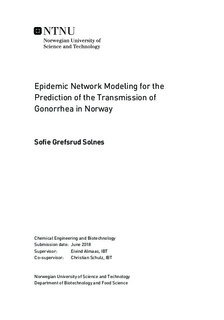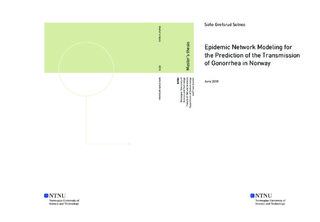| dc.description.abstract | The number of gonorrhea infections among men who have sex with men (MSM) in Norway continues to rise, and in 2017 the number of infections increased with more than 50 % relative to 2016. This has resulted in various campaigns to encourage people to always use prophylactics and to get tested more frequently. The use of stochastic epidemic modeling on networks to understand and predict present and future epidemics is increasingly important. The world is becoming smaller and more connected with easy and cheap travel, thus making infections spread faster on the global scale. This further exacerbated by the emerging global issue of antimicrobial resistance (AMR), spurred by the mis- and overuse of antibiotics. The growing AMR problem is also increasing the risk of prevention and treatment of infections, medical procedures and cancer treatment and increases costs of health care. The use of network epidemic models for the transmission of infections is getting more advanced and useful as spatial and geolocation data now is the norm.
The aim of this thesis was to create epidemic network models with specific parameters that were able to capture the temporal dynamics of the spread of gonorrhea in Norway in a sequence of years, using reports and statistics from Folkehelseinstituttet (FHI). Altogether the following ten SIS/SIR/SIERS epidemic network models were built: Four models using FHI reports, one model to predict the gonorrhea spread in 2018, two for the initial spread only seeded from Oslo and three models for the AMR transmission.
Of the ten models built, the four SIS epidemic network models using FHI reports and the 2018 model proved to yield the most interesting results, by capturing some key characteristics of the transmission of gonorrhea. With parameter combinations of the recovery rate (alpha) and the transmission rate (\beta) in the models, the total cumulative number of infected MSM in Norway was retrieved with an average discrepancy of 3.7 % from the reports for the respective years. The parameters were constant for all the models, with the exception of the probability of exposure to infection (beta_2,G5). The parameter beta_2,G5 was increased with an average of 1.2 % every year. The 2018 model was generated using the increase of beta_2,G5 and predicted an increase of 14.7 % in the number of gonorrhea cases among MSM in Norway compared to 2017. | |

